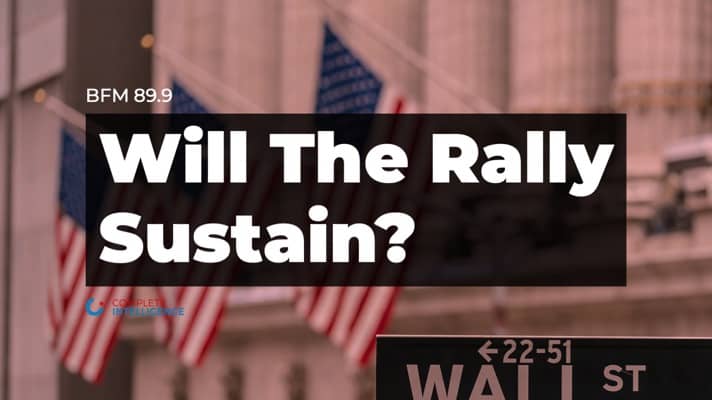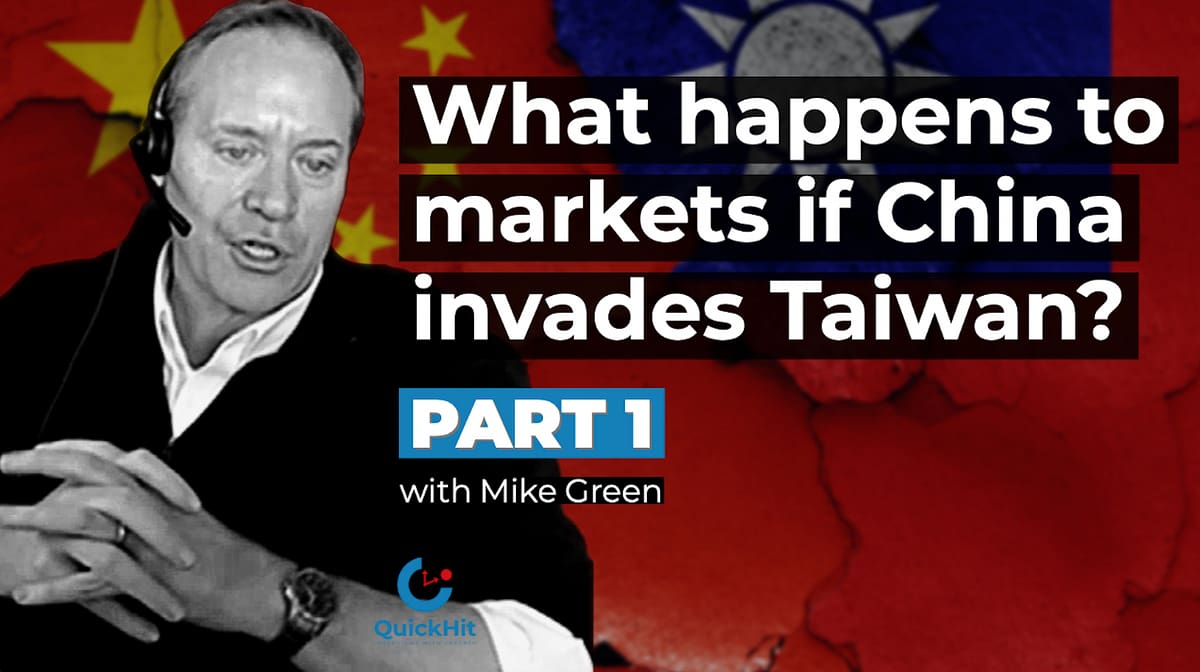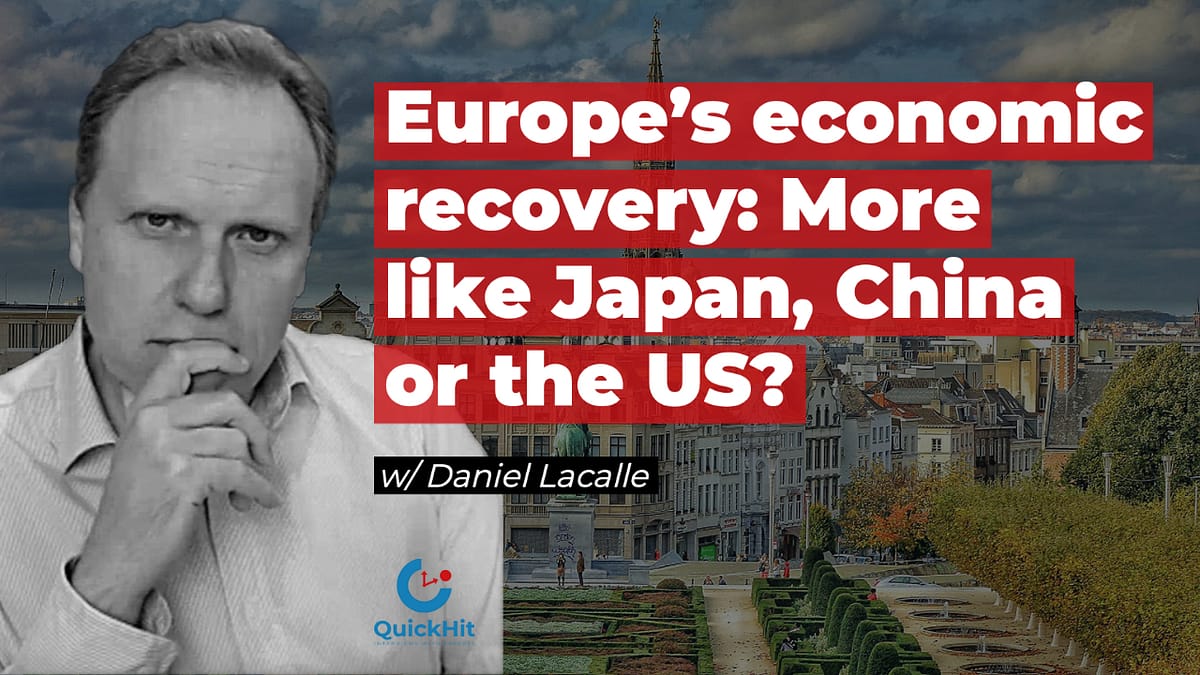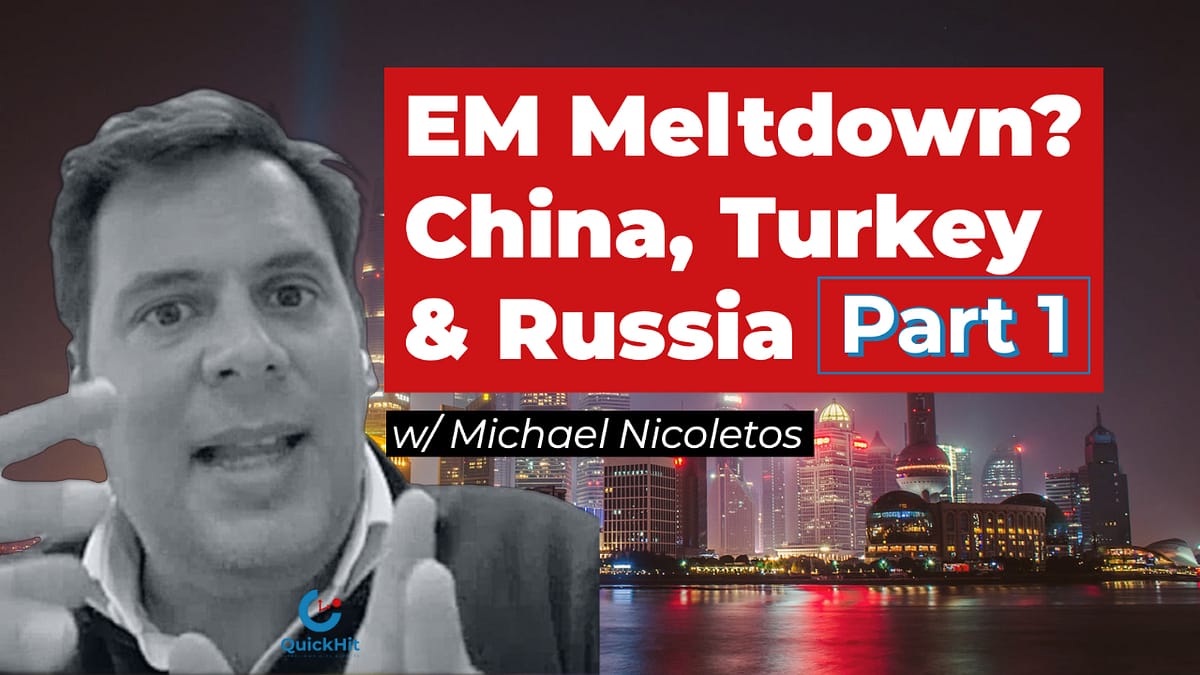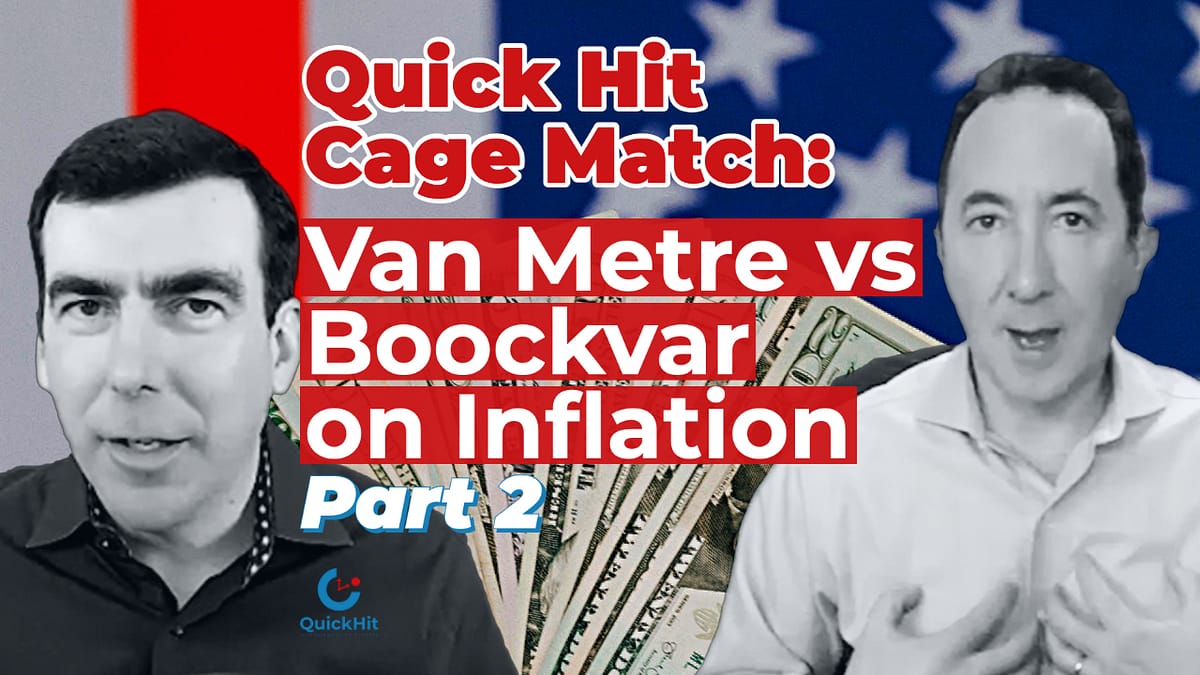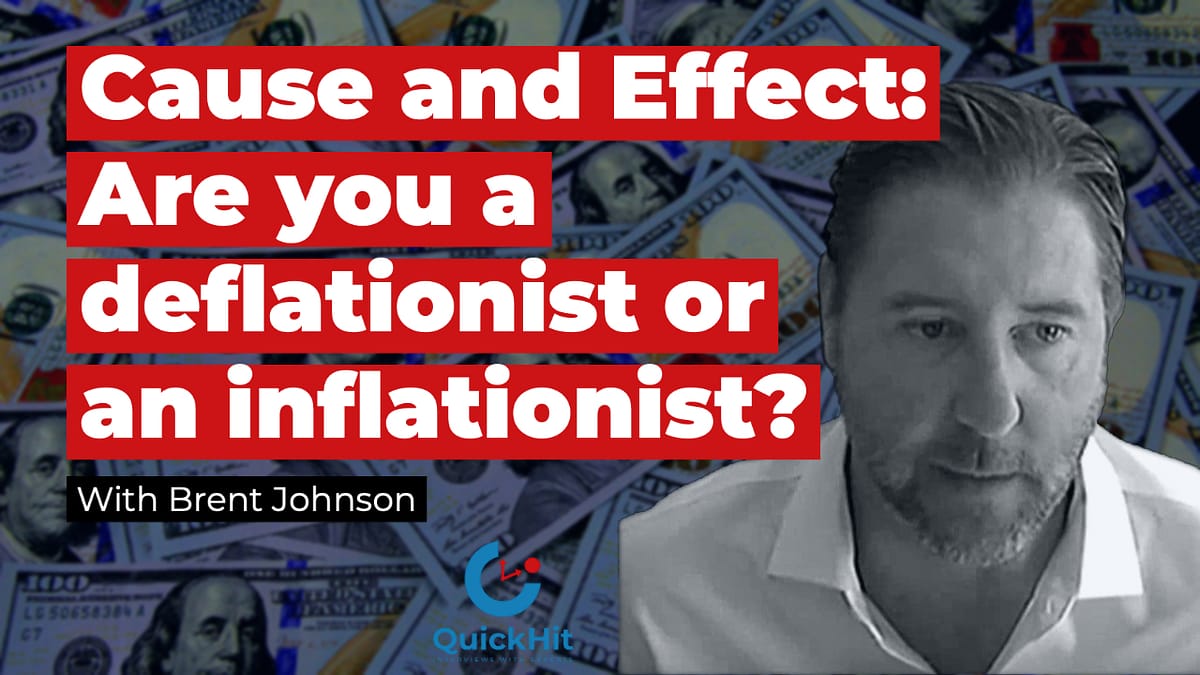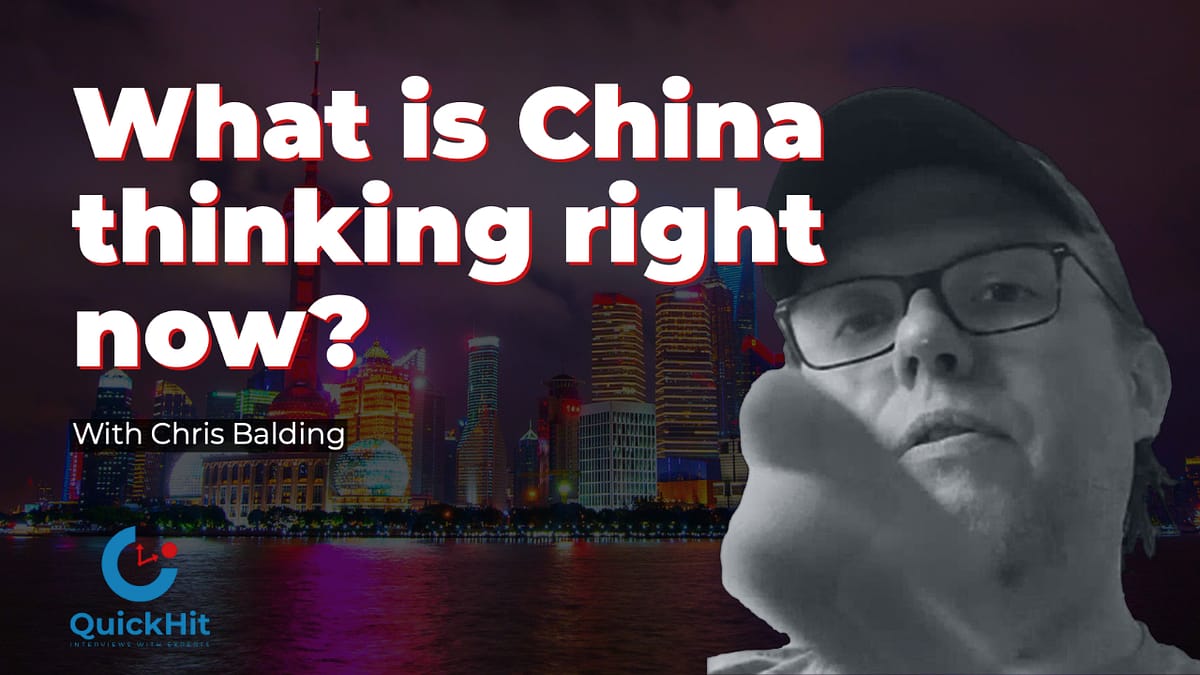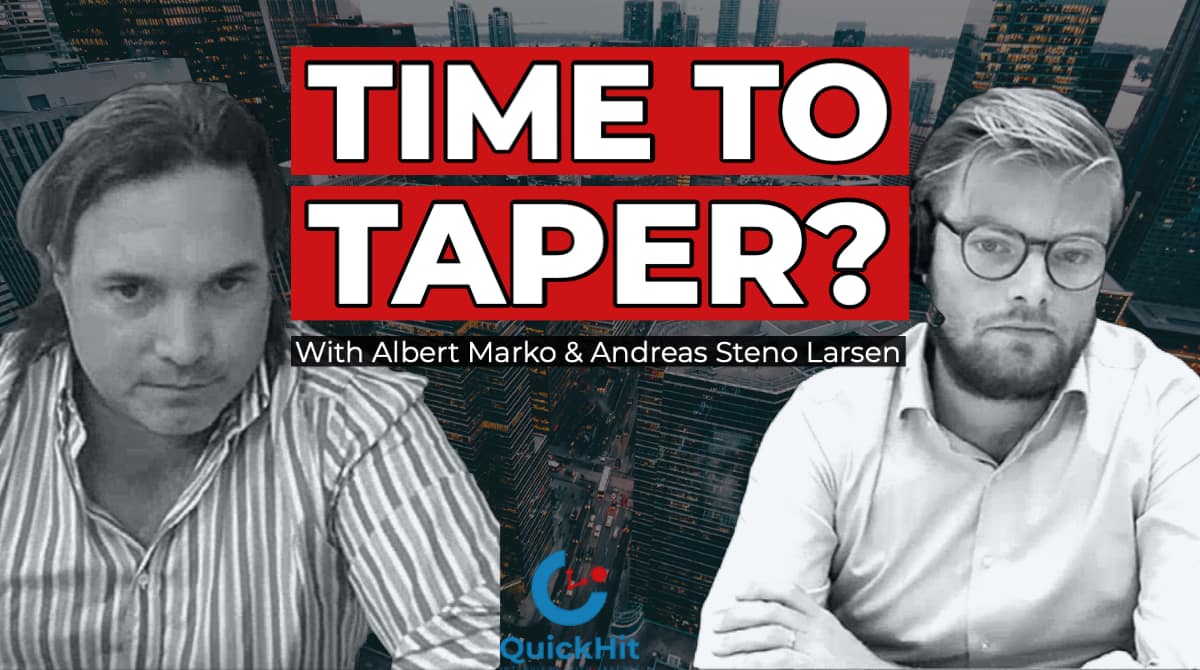China expert Chris Balding joins us this week for #QuickHit to discuss “What China is thinking right now?” What is the state of the Chinese economy? Are they really doing well in Covid? How about the deleveraging process, is that even real? And what’s happening to CNY? Also talked about are the politics around China especially how it relates to Afghanistan.
Subscribe to our Youtube Channel.
💌 Subscribe to CI Newsletter and gain AI-driven intelligence.
📊 Forward-looking companies become more profitable with Complete Intelligence. The only fully automated and globally integrated AI platform for smarter cost and revenue planning. Book a demo here.
📈 Check out the CI Futures platform to forecast currencies, commodities, and equity indices
This QuickHit episode was recorded on August 24, 2021.
The views and opinions expressed in this Sentiment has soured: How will governments and companies respond? (Part 1) QuickHit episode are those of the guest and do not necessarily reflect the official policy or position of Complete Intelligence. Any contents provided by our guest are of their opinion and are not intended to malign any political party, religion, ethnic group, club, organization, company, individual or anyone or anything.
Show Notes
TN: Hi, everyone. Thanks for joining us for another QuickHit. My name is Tony Nash with Complete Intelligence. Today we’re talking with Christopher Balding about what is China thinking now.
Chris, thanks for joining us. Can you let us know a few things about yourself? Give us a little background?
CB: Sure. I was a professor at Peking University in China for nine years and then two years in Vietnam at the Fulbright University Vietnam. And today I am a super genius in the United States.
TN: Yes, you are. Thanks for taking the time, Chris. You’re one of the very few people I know who’ve actually had on the ground experience in China with a Chinese government organization.
So I think it’s really important to go to people like you, who had experience like you to understand what kind of China or the Chinese government is thinking now. Of course, it’s not monolithic. There are a lot of different opinions, but it’s good to have that insider’s view.
So I want to start off as we look at where we are in COVID, we’re a year and a half into it, depending on the school of thought, maybe it did or didn’t start in China, but we hear that Chinese economy is doing great and they’ve come out of COVID really well, all these other things. I’m really curious your view on the state of the Chinese economy right now. And what are Chinese economic planners thinking right now as they kind of potentially go into year two of Covid.
CB: So I think there is a couple of highlights out of the Chinese economy. First of all is that they’ve resorted to the pretty similar playbook that they go back to every year, which is pump credit, pump construction and infrastructure type spending.
In the early part of this year, we saw a significant amounts of credit growth. That’s softened as we’ve moved into summertime. That’s primarily due to because there’s a very clear summer and fall building season that allows builders in China to do things because the weather becomes inclement in significant parts of the year. And then if you add in the Corona backlog, that kind of is essentially almost trying to put two years of expected growth into one year.
We actually saw a lot of that. And that front loaded a lot of the credit and demand for things like commodities. This is why you’ve seen such demand for things like coal and steel, which were quite high. We’ve seen that soften as firms built their inventory and really ramped up during the summer building season as the demand for credit has softened and some of the building has actually been undertaken. You’ve seen a softening of that which has caused you’ve already seen talk of maybe there’s going to be unleashing or the economy is a little bit softer than the planners would like. So there’s talk of unleashing some additional credit growth trying to stimulate different parts of the economy. We’ll have to wait and see if that happens.

This chart of ICE Rotterdam Coal is generated from CI Futures, an app forecasting nearly a thousand assets across currencies, commodities, market indices, and economics using artificial intelligence and machine learning technologies. Curious how it can you and your business? Book a time with our expert and get free trial.

This chart of Steel is generated from CI Futures, an app forecasting nearly a thousand assets across currencies, commodities, market indices, and economics using artificial intelligence and machine learning technologies. Curious how it can you and your business? Book a time with our expert and get free trial.
Generally speaking, the rule is, if there’s a debate about whether or not they’re going to unleash credit growth, I would definitely take the over.
TN: By about three times. Right. So one of the interesting things you mentioned is that you said that they expended credit in the early part of this year. But what I read from investment banks and what I’ve read from other people who look at China is that China just underwent this big deleveraging process. Is that real? I’m just not sure, because I see on one side that there’s this talk about deleveraging, but my gut tells me it may not necessarily be happening. Is it happening, or is it something that’s just happening on paper or what’s your view?
CB: It’s tough to understand the Chinese National Bureau of Statistics and PBOC’s math as to how they arrived at that, because if you’re just running more generalized numbers, it’s very clear that debt at all levels has continued to outpace GDP. So it’s very difficult to understand how they’re estimating a leveraging. And it’s important to note that we did not see, let’s say, the rapid, rapid expansion of economic growth that you saw, for instance, in the United States.

This chart of China GDP is generated from CI Futures, an app forecasting nearly a thousand assets across currencies, commodities, market indices, and economics using artificial intelligence and machine learning technologies. Curious how it can you and your business? Book a time with our expert and get free trial.
And what I mean by that is, whereas any United States, maybe growth went from two or three to 5% relative, almost doubling, you know. You probably saw Chinese growth go for maybe like 5% last year to seven or 8% with the Corona boost where you have that base effect. And so you didn’t see it go to, like, 10, 12, 15% that you might have seen if it had really in relative terms, they doubled from the previous year.
And so it’s very difficult to understand how they arrive at those deleveraging numbers. And as we all know, China is famous for fudging their numbers. So it’s very difficult to understand how they’re arriving at those numbers.
TN: Right. No, I agree. I haven’t believed it when I’ve heard it, but I kind of nod along as if it’s real. But I think, you know, the Chinese economic data a lot more intimately than I do, but I just don’t see where it’s happening, where it’s actually materializing instead of just being debt transfers.
Okay. So earlier you said that Chinese economy is slowing. Now, from my perspective, that’s worrisome partly because you’re going into a big export season, and we’ve got some ports that are stopped up. We’ve also got an election next year with Xi Jinping being reelected, whether that’s in square quotes or not, but Xi Jinping being reelected next year.
In terms of the resources put towards stimulus this time around, do you expect that to be more intensive than normal?
CB: Typically, what you see. And you saw this the first time Xi was elected, you saw this second time Xi was elected. What you typically see is a pretty significant boost to fiscal outlays. And so I think if history is any guide, I think you’re probably going to see going in the fall and the first of year, it’s very, very likely you’re going to see some type of significant boost to fiscal outlays. And this pattern goes back many, many years well before Xi that when there are these elections. And I’m not sure if it’s a scare quotes or air quotes, but both seem to…
TN: Yeah.
CB: So I think it is very, very likely that you’re likely to see that. And one of the things I think that a lot of people have missed out on is yes, there were absolutely corporate, let’s say, bailouts or corporate funds for Corona. But one of the things is that in the United States, there were the large amounts of transfers directly to households. China has not enjoyed those transfers directly to households.
And so actually, consumer spending in China is actually pretty soft. And those are buying inflated data standards. And so I think that is something that is very important to note when we’re talking about the health of the Chinese consumer.
TN: Yep. That’s great. Okay. So I also want to talk about the supply chain issues. And I was just reading a story today about how Pudong Airport has been shut down. Cargo on Pudong Airport is going to be much slower for a period of time because of anothe Covid outbreak. This sort of thing. Do you see ongoing port capacity issues related to COVID? Is that something that you’re kind of concerned about?
CB: I think that is something that you’re going to be seeing for definitely the foreseeable future. And I should say it’s not just China. You’re seeing a lot of this in other parts of the world that I know, specifically Vietnam, the Middle East. I’ve heard of similar things in Europe where they are just straining at capacity. Sometimes it’s due to COVID shut down. Sometimes it’s due to other issues. But absolutely, these are issues that I think are not going away anytime soon.
And it is, I mean one of the debates in the United States right now is transitory or structural inflation. And I think, not to be capping out on the issue, but I do think it is kind of a mix of both. And I think the supply chain issues don’t be surprised if we’re looking at very likely two years before all these issues are really worked through, because when people went to, let’s say, just in time or contract manufacturing, what that did is that gave you less wiggle room. So you did not just have a massive warehouse of supply that you inventory, and then you could draw down as necessary where it would give you three months to make a mistake. Now people were essentially saying, I got one week of inventory, and if that one week gets shot, I’m in deep trouble.
So the chips are, there’s chips, there’s car, there’s Corona shutdowns, there’s capacity issues at some ports. And so it’s going to take a couple of years, probably to work through all these issues to return to what we think of as some degree of normalcy.
TN: Right. What’s interesting to me about that is the previous administration of the US tried to bring manufacturing businesses back to the US.
Now, with COVID because of the global supply chain issues and the intermittent supply issues, there’s more of a move to bring things back, at least to North America. I know lots going into Mexico right now. Some’s going into the US to minimize the disruption of things, especially in electronic supply chain.
So it seems like regardless of the kind of official policy, whether it’s trade policy or just say public health policy, it looks like more of this regionalization is happening. Does that make sense to you?
CB: Yeah, absolutely. I mean, look, nobody is going to announce that they’re leaving China for many reasons. But nobody’s going to announce that they’re leaving China. But you do absolutely see a spread of manufacturing capabilities.
Whether that is because they want to have multiple manufacturing bases, they want to be more diversified, whether it’s because of IT issues, whether it’s because of Corona risks, tariffs, all of these issues, there is absolutely increasing diversification of manufacturing capabilities, whether it’s Mexico, India, Malaysia, all of these different places. You’ve even seen Africa doing relatively well in certain areas. So it has absolutely happened.
TN: Okay. One last question on the economy then we’ll move to kind of politics and China’s place in the world. What’s the thought behind the elevated CNY? We’re trading much higher than we have for a long time, and it stayed there, right? It’s pegged right around 6.4 something, and it’s been there since Q1, I think. Why the persistent strength in CNY?
CB: Well, I mean, I think first of all, they have been running during Corona pretty significant surpluses. The United States has exports to China and other parts of the world have declined, not insignificantly or remained flat as we’re importing a lot more. That’s number one.
I think also the dollar has gone into a specific range. And the way that I think of the CNY is it’s basically just a reverse USB tracker, which I think explains most of what we’re seeing. I think what they’re trying to do and the reason that China has been buying some dollars, not in major amounts, but I think they kind of have, like, ICBC and CCB, those types of banks acting as dollar cushions for lack of a better term, is that they don’t want it to appreciate too much for a number of reasons, because they know they’ve become more expensive and that would just make it that much more expensive. So in a way, I think they’re trying to manage that, manage that flow. But I think it’s still generally within a range where it’s like you can say they’re within spitting distance of what their index say they should be. Okay, that’s fair.

This chart of USD/CNY is generated from CI Futures, an app forecasting nearly a thousand assets across currencies, commodities, market indices, and economics using artificial intelligence and machine learning technologies. Curious how it can you and your business? Book a time with our expert and get free trial.
TN: Okay. Now let’s move on to politics. Let’s move on to kind of China’s big, long term, multi hundred year plan to rule the world, which I think is not real.
So let’s talk about Afghanistan. This just happened over the last couple of weeks, and there’s a few that China is going to be the master winner of the US withdrawal from Afghanistan. I think there are multiple perspectives on that, but the consensus view seems to be that the US really did had to job on the withdrawal. And the ultimate winner of this is China. Can you kind of walk me through some of your views on that? What are some of the possibilities there with China and Afghanistan?
CB: Sure. So I think it is very fair to say that the United States has pretty badly bungled the withdrawal. You know, why, you know, we should have waited until we’d already evacuated all the army to say we’re going to start evacuating US citizens and Afghani translators and people like that.
One of the things I do think is absolutely happening. And this is not just China. And you’ve heard this from country after country. Taiwan, Germany, UK on down is they are saying we need to go back to the drawing board and re evaluate everything we think we know.
Okay. And somebody that I was talking to, I think, expressed it very well is the United States still has credibility because we can move large amounts of assets, whether it’s military, governmental, other private sector, we can bring significant assets and influence to the table. What, this has really changed in a lot of people’s minds is confidence.
TN: Yes. That’s fair.
CB: That has changed a lot of people’s mind. So you have a lot of people going back to the drawing board. One of the things I’m going to be a little bit hesitant to do is start pronouncing winners, losers, and this is what XYZ country is going to do in ABC country is going to do. And the reason I say that is it’s very, very plausible to construct a scenario where the Taliban and the CCP become BFFs. Okay?
TN: Sure.
CB: I mean, if China is shipping large amounts of fentanyl out of northeast China, it’s not a crazy scenario to say they partner with the Taliban to start shipping large amounts of opium into the United States at the same time.
TN: Sure.
CB: Not a crazy scenario. It’s also not a crazy scenario for the Taliban to start bombing China within a year or two. Okay. You could very easily construct those types of scenarios that lead to that. Okay. So it’s very, very difficult to construct those types of scenarios with any what I would consider a degree of certainty. Okay?
TN: Sure. So what about the, the China-Pakistan relationship? $46 billion of investment, supposedly, supposedly a tight relationship there. That’s arguable. Do you think that pays dividends in Afghanistan, or is that kind of something that’s a little bit, I wouldn’t say irrelevant, but a little bit less directly connected.
CB: So I think Pakistan is actually very pretty directly involved in all of this. But again, it’s very difficult to say with a high degree of certainty what’s happening there because Pakistan has very direct connections into both the Taliban, Al Qaeda. Some would even say that they were a Pakistani security service creation. At the same time, it’s well known that there are blood feuds between groups within each of those organizations.
So it’s very difficult to get to say exactly who the winner, loser there. With regards to China and Pakistan, one of the things that you’ve seen very clearly is that pretty much the Pakistani government and the Pakistani elites are effectively compromised by China. They will say nothing about wingers and other issues.
At the same time, everything, I think indicative on the ground and of the mass population is that there is maybe not extreme, but I would say broad discontent with the Pakistani relationship with China for many reasons.
TN: From who and Pakistan? Is it from the armed forces? Is it from other parts of the government, from regular folks who isn’t happy with that relationship?
CB: I think a lot of folks broadly. The business community. I think there’s a growing sense that they are effectively a Chinese colony. One Pakistani I know who described it as such. So I think there is very broad discontent. And as we all know, Pakistan has quite the lengthy history of governmental instability.
So similar to what you’ve seen in other countries in the region, it’s very easy to paint a picture, a scenario where the current government remains compromised and under the thumb of the CCP for years to come. I think it’s also plausible that a new government or some type of political instability happens in Pakistan. And all of a sudden, there’s an about face on how to manage relationships with China.
Generally speaking, though, I think there is going to be very tight coordination between Beijing, Islamabad and Kabul because those… Pakistan, I mean, almost anything that happens in Afghanistan is going to be maybe not controlled by Pakistan. I think that overstate it. But there’s going to be large amounts of information flows and influence back and forth happens over what happens in Afghanistan.
TN: Yeah. Okay. That’s all really interesting. I think we could spend a long time talking about China, Pakistan, Afghanistan, India, Russia, kind of where all those countries come together, Central Asia. But I want to end on this.
We’ve seen, a lot really changed with US standing in the world over the past couple of weeks over Afghanistan. We’ve seen a lot change in the US China relationship over the past year with the new administration. And so let’s talk for a minute about the overall US China relationship. What’s your thought there? Are they getting along? Is there a constructive dialogue? How do issues like Taiwan fit within that discussion? Can you just help me think about some of your thoughts there?
CB: So I was talking to someone, and I think they put succinctly the way that I would characterize the Biden administration’s record on China. You can’t criticize them for what they’ve done on China because they really haven’t done anything at all. Okay. Other than adding a couple of names to the Sanctiosn books, there really has not anything taken place.
They promised that they were going to get out their China strategy plan in June. Then there were rumblings that might happen in July, where now at almost rapidly approaching September 1. And now there’s not even talk of when it might be released. So really, nothing has been happened except for the Alaska meeting, which apparently went over like a lead balloon.
Everything right now just seems to be a stalemate. And the Biden administration is worrying, and that China is still moving forward, and the Biden administration is basically doing nothing.
The most telling point to me about the by administration approach, and I think this is something I think you should fault in. In fairness, Trump for is look, we can talk about values and do the right thing and all this kind of good stuff. But the United States, at some point has to actually put resources into this effort.
And the Trump administration, other than political capital with allies or other countries, never put any real hard resources or assets into these issues. And the point I would make is the Biden administration has made a point of spending literally trillions of dollars. And to the best of my knowledge, there has been almost zero spending passed that has really anything to do with China. Okay.
We cannot continue to talk to countries like Vietnam, Malaysia, South Korea, Japan. You cannot talk about the threat China poses and never spend any money on the issue.
TN: Sure.
CB: Okay. And look, this doesn’t have to mean we go out and increase military spending by 20%. This could simply mean we’re going to go into Vietnam and say, we want to have a development program and, you know, help solve issues. This can mean capitalizing the Development Finance Corporation to help countries like India and Malaysia and say, look, there is a real opportunity that does not involve the Belt and Road, where there’s going to be green standards or these non-corrupt standards and things like this to make sure that this money is really helping your country. You know, and it was probably something that was negotiated could be all the way back to the Obama administration.
There was some type of military center opened in, I believe, Jakarta with the Indonesian government that was supposed to have other governments. It’s a small center. Even those types of things. There’s simply not the resources being dedicated. And I think that’s indicative of where this ranks within the Biden administration priorities.
TN: I’ll be honest, Chris, it sounds like a mess. It sounds pretty bleak to me.
So great. I really appreciate this. I think if anybody knows has an idea of what China is thinking, I think you’re the guy. And I really, really appreciate your time.
Everyone watching. Please please subscribe to our YouTube channel. The more we have, the more we can bring to you as a part of our videos. And, Chris, thank you so much. And thanks to everyone. We’ll see you on the next interview. Thanks.

